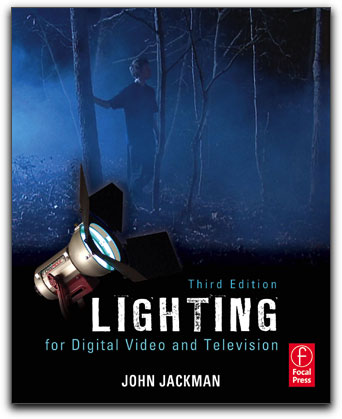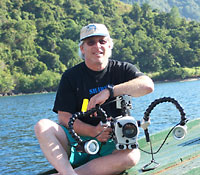
May 24, 2010
By John Jackman www.focalpress.com - $44.94
Review by Steve Douglas
This is another book that requires that you take your time with it. There are too many goodies for you to want to rush through and miss something. It is certainly not a skim and scan novel but a very well written and informative book covering more than just lighting suggestions and positions. Yes, it provides those subjects as well but, just as interesting are the early chapters regarding the early history of film lighting equipment and the differences between the physiology of the eye and ability of the camera lens and how much we can see versus the camera's limitations. Armed with excellent color graphics related to using and understanding the waveform, vectorscope and different types and arrangement of lights, John Jackman provides the reader with a real understanding of what the shooter is doing and what they should be doing.
A prequel to some of the later chapters was a history lesson in just how the Kelvin scale came about which I found very interesting. This led on to the topic of the many different types of lighting, their advantages and disadvantages and is wholly up to date right through the use of fluorescent and LED lighting.
One of the most important of all the chapters, (Chapter 3) really has nothing to do with lighting at all but with a thorough review of volts, amps and watts and how they are such an important consideration long before you set up for a shoot. What is so meaningful here are the resultant issues of safety, not only to the life of the lighting equipment but, even more importantly to the safety of the entire house or set where the shoot is being held at. It has certainly made me go back and check my outlets since my home was built in the early 1950's. While there were a whole bunch of mathematical considerations for the amount of watts and amps being drawn depending upon the type of lighting used that may have gone over my head, the point was drilled in that safety first is a high priority. I actually went and threw out one of the stingers I normally used that had been showing considerable wear. I'm one of those types that will hoard equipment forever, but after reading this, I had no regrets dumping that stinger in the trash. Heck, why take the chance?
If you don't know a tota light from a omni from a soft box or a fresnel; if you are unsure how to light a scene to achieve a particular look; if you think that lighting for a night shoot is to simply take your cam out at night and press 'record', if you fail to understand the difference between hard and soft light or find lighting terminology undecipherable, than this book is a must. Even if you already know all those things there are excellent and useful chapters for the advanced shooter and lighting tech covering low budget setups, advanced lighting setups. Studio lighting vs outdoor shoots, the establishment of mood, product shooting, interior and exterior and lighting techniques for different skin tones are all covered.
As informative and well illustrated as this book is, I guarantee that you will find it an interesting read simply due to John Jackman's own writing style. As I said, this is not a fast read only because I found it too interesting to want to skim through. There is a lot to absorb here and relate to my own work, so I am devouring as much as I can when I can.
A point was made somewhere in this book that I recall when he said that so many new shooters just jump into the craft without the full knowledge and understanding of the what, when and why of lighting considerations. It's like a new videographer who points and shoots without bothering to read the camcorder manual, doesn't bother to learn the simple concept of what white balance is or why it is important. I have personally met many of these folk who ignore my encouragement to really learn so that their efforts will only be improved. Some take my advice to heart and, for them, I would highly recommend Focal Press's 'Lighting for Digital Video and Television' for any level of shooter, lighting director and editor.

Steve Douglas is a certified Apple Pro for Final Cut Pro 7 and underwater videographer. A winner of the 1999 Pacific Coast Underwater Film Competition, 2003 IVIE competition, 2004 Los Angeles Underwater Photographic competition, and the prestigious 2005 International Beneath the Sea Film Competition, where he also won the Stan Waterman Award for Excellence in Underwater Videography and 'Diver of the Year', Steve was a safety diver on the feature film "The Deep Blue Sea", contributed footage to the Seaworld Park's Atlantis production, and productions for National Geographic and the History channels. Steve was a feature writer for Asian Diver Magazine and is one of the founding organizers of the San Diego UnderSea Film Exhibition. He is available for both private and group seminars for Final Cut Pro and leads underwater filming expeditions and African safaris with upcoming excursions to the Cocos Islands, Costa Rica, Lembeh Straits, Indonesia, and Wakatobi. Feel free to contact him if you are interested in joining Steve on any of these exciting trips. www.worldfilmsandtravel.com
[Top]
copyright © Steve Douglas 2010
are either registered trademarks or trademarks of Apple. Other company and product names may be trademarks of their respective owners.
All screen captures, images, and textual references are the property and trademark of their creators/owners/publishers.